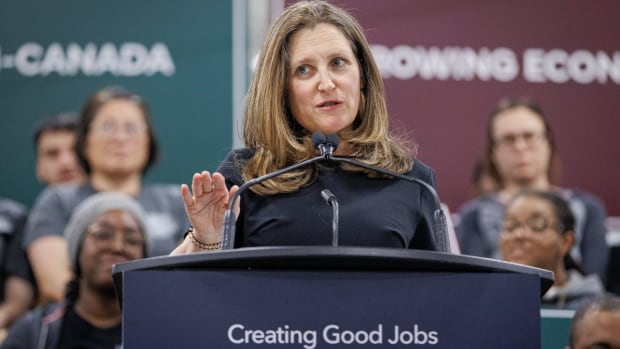[ad_1]
The federal budget, set for Tuesday, will include a grocery rebate measure aimed at lower income Canadians to help address the affordability crisis, particularly to mitigate the rising cost of food, CBC News has learned.
A senior government official familiar with the budget, but not authorized to speak publicly before the budget is rolled out, told CBC News that the overall cost of the measure is “north of $2 billion” and will benefit 11 million households. It will be facilitated through the GST credit, aimed at lower income families.
“It’s being called a grocery rebate,” said the source, but noted the rebate amount will not be based on a person’s grocery expenditures, nor will the government require that the one-time payment be spent on groceries.
“It’s a targeted measure that won’t add fuel to the inflation fire,” said the source.
The source explained that a single person with no children could get a one-time payment of up to $234, while a couple with two children could receive up to $467 and a senior citizen about $225. The timing of these payments will depend on how quickly the government can get the legislation to implement the budget passed.
Tuesday’s budget will have other affordability measures as well. CBC News can confirm that the government plans to crack down on so-called junk fees for consumers, first reported by Canadian Press. Junk fees are hidden or unexpected consumer charges that are tacked on to the initial price of a product or service, ultimately inflating the total cost.
Ottawa will have to work with various regulatory agencies and the provinces and territories to eliminate junk fees. Sectors that might be affected by the crackdown include phone and internet providers and large event ticket sellers.
The federal budget will also include an increase to the limit on what students can withdraw from their registered education savings plan (RESP) for post-secondary education. Right now, the yearly limit on the education assistance payment (EAP), which is the investment earnings and government grant portions of the RESP, is $5,000. The federal government plans to increase that to $8,000 annually, to reflect the rising cost of college and university.
There is no limit on the post secondary education (PSE) withdrawals, which are the contributions made by the subscriber.
Investments in clean industrial economy
Other affordability measures are also expected in the budget and money has been set aside for pay for recent health-care deals made with the provinces and territories.
A key plank of the budget will also be investments in the clean industrial economy, spurred in part by the U.S. Inflation Reduction Act (IRA), which will pump hundreds of billions of dollars into clean energy in that country.
CBC News can also confirm a Reuters report that the budget will include a tax credit for clean tech manufacturing worth 30 per cent of capital investment costs in manufacturing equipment.
The government source used the critical mineral sector as an example of where the government wants to accelerate production. The tax credit would provide an incentive to mine and process critical minerals, with the recognition that there is a growing demand for them in the U.S., particularly for the electric vehicle market.
The source said that the new tax credit is one of the bigger tax measures that will be part of a comprehensive package the Liberal government will bring in to match or complement what the U.S. is doing with its Inflation Reduction Act.
The budget will also provide greater detail about two tax credits first proposed in last November’s fall economic statement. The Clean Hydrogen Tax Credit and the Clean Tech Investment Tax Credit will take shape in this budget. Companies that invest in those areas and do so in a way that boosts pay for workers will benefit the most, said the source.
“There are similar positive incentives for unionized workers in the U.S.’s IRA. We mirror that in some ways,” said the source, adding that the government has been consulting organized labour over the last two months to ensure budget measures are not “designed in isolation.”
In fact, the new tax credits will be worth more to employers if their workers are paid more, said the source.
The source would not specify whether there’s a projection for a balanced budget.
The fall economic statement projected a balanced budget by 2028 — the first time the Liberal government had projected a balanced budget since it was first elected in 2015.
But economic growth is significantly weaker now.
“Expect to see the fiscal picture adjusted, not because of expenditures, but because nominal GDP growth is hugely different from a year ago,” said the source.
The slow growth might also impact the debt-to-GDP ratio, a key fiscal anchor for the government that has relied on a downward trajectory of the ratio to reassure Canadians that deficit spending is not out of control.
[ad_2]
Source link




